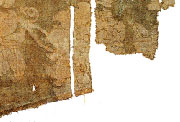 |
 |
|||||||||||||||||
 |
||||||||||||||||||
 |
||||||||||||||||||
| Classified Glossary | ||||||||||||||||||
 |
||||||||||||||||||
 |
||||||||||||||||||
| 6. 1Dimension For textiles that could be identified with a warp and weft, the dimension along the warp is the length (changdu), along the weft is the width (kuandu). The woven edges of the finished textile are the selvage (fubian), the dimension between the selvages is the loom width (menfu). The woven selvage running parallel to the weft is the transverse selvage (jitou), which is often marked with an inscription (zhikuan), the mark of the manufacturer since the 17th century. 7. 1Warp/weft Warp (jing) refers to all the threads running parallel to the length of the loom, the individual thread is called an end (jingxian), a particular set called group (tao). Weft (wei) refers to all the threads running parallel to the width of the loom, an individual thread is a lat (weixian), one shuttle movement creates a horizontal line called a pick (suo), and a pass (fu) is one complete unit of lats. Thread count (midu) is the number of ends in the warp and lats of weft within a measuring unit, usually in cm. 8. 1Weave The interlacing of the warp and weft at a right angle creates a weave (zuzhi), the result is a structure (jiegou). The word bind (jiaozhi) is also used, specifically for the interlacing of one end in the warp and one lat in the weft, the system is the binding system (jiaozhixitong). The unit of the repeat in the structure is the weave unit (danweizuzhi). Within the unit, the number of threads in the warp and weft is called the end (mei), usually indicated as k-end. |
||||||||||||||||||
| THE BOOK | ||||||||||||||||||
| AUTHOR | ||||||||||||||||||
| CONTENTS | ||||||||||||||||||
| ORDER | ||||||||||||||||||
| CONTACT | ||||||||||||||||||
| LINKS | ||||||||||||||||||